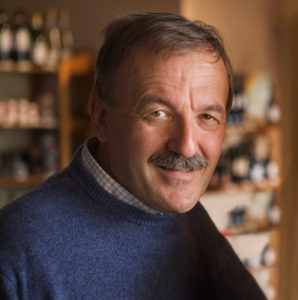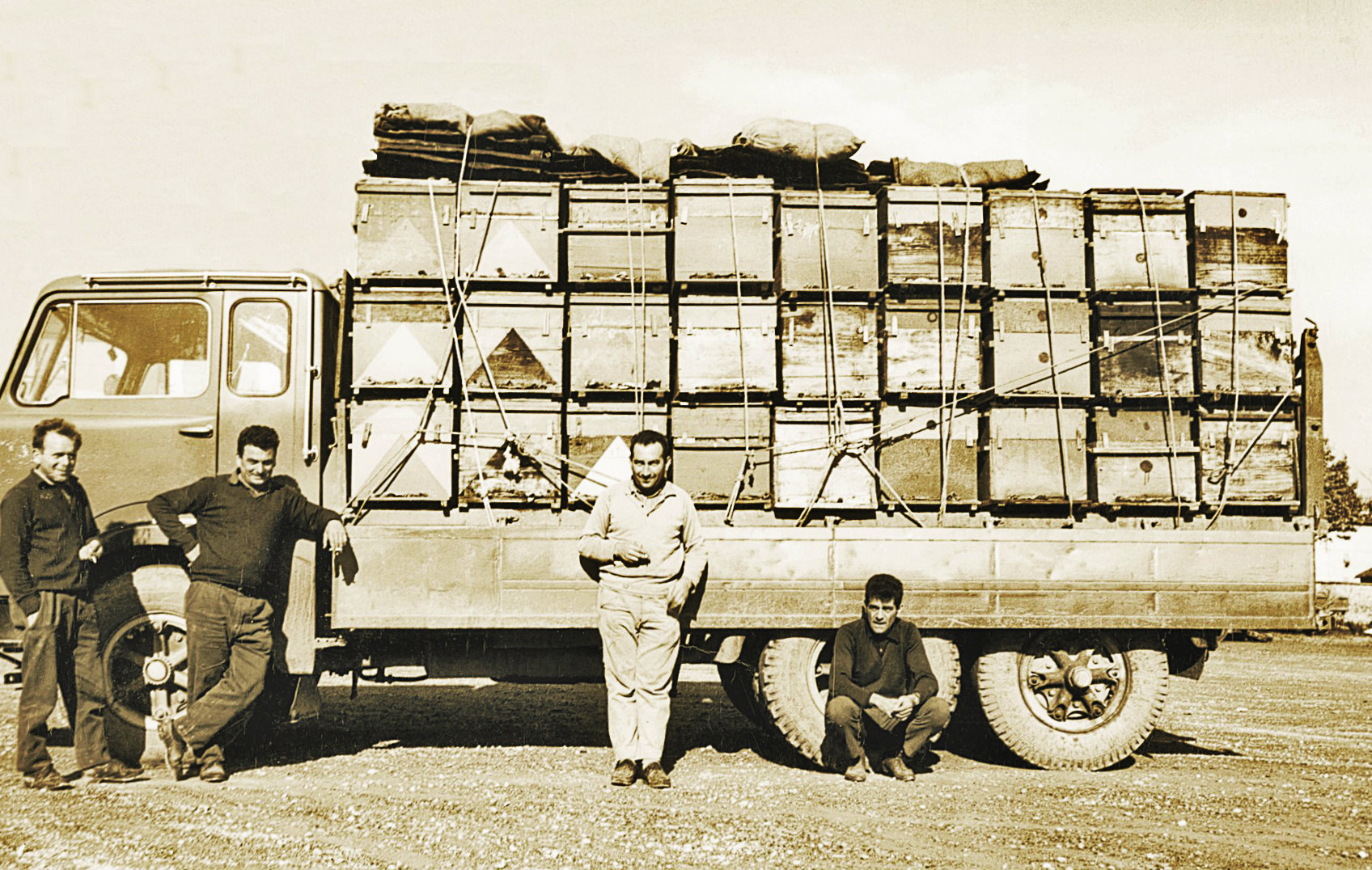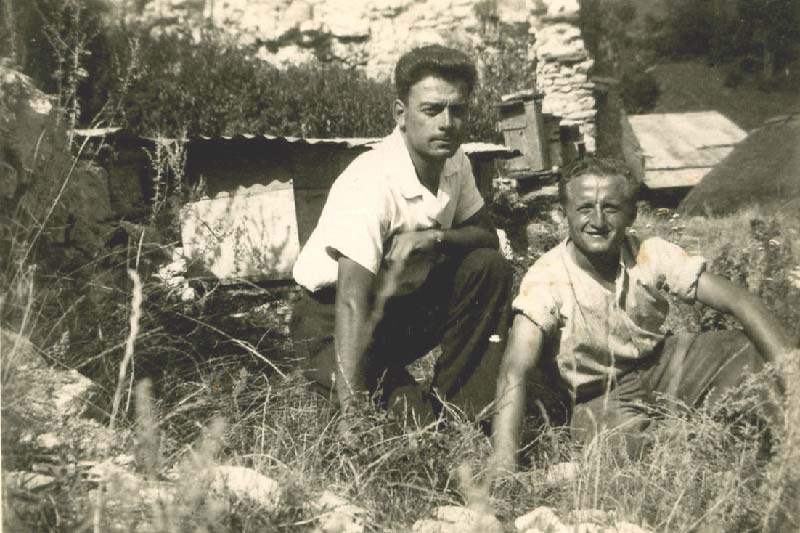Giuseppe Brezzo, seconda generazione della famiglia, ci racconta la straordinaria avventura del padre Gervasio, pioniere del miele piemontese e dell’apicoltura nomade: tra studio, fatica e dedizione alla sua terra.

Giuseppe Brezzo
Il miele nel sangue. Nelle punture delle api a cui, dopo un po’, fai l’abitudine. Il miele sulle spalle. La cui pelle diventa come cuoio dopo che, per tutta la notte, carichi e scarichi le arnie per raggiungere i prati della Valle Maira, dove far bottinare le api sui fiori di montagna. Il miele nelle gambe. Quando per anni imbracci la bicicletta e pedali da Monteu Roero a Reaglie, tra Torino e Pino Torinese, ad ascoltare le lezioni di Don Giacomo Angeleri, il primo maestro di apicoltura in Piemonte.
La famiglia Brezzo ha un rapporto speciale con il miele. Una storia di sacrifici, di passione, di attese, di sfide. Soprattutto di fatica e di imprenditoria volta a valorizzare e promuovere un prodotto che, poco più di 50 anni fa, era tenuto in poca considerazione, utilizzato per curare un raffreddore, al più per lenire gli effetti del mal di gola.
«Ho “giocato” con le api fin dai primi anni della mia infanzia. Mi pungevano in continuazione perché imitavo mio padre che curava gli alveari in un prato vicino a casa», racconta Giuseppe Brezzo, figlio di Gervasio, fondatore, nel 1948, dell’omonima azienda. «Dopo la guerra, la mia famiglia aveva deciso di affiancare al lavoro della campagna e delle vigne – quasi distrutte dalla fillossera – una produzione di miele del Roero. Era un mezzo come altri per uscire dalla miseria di quegli anni, per integrare il salario. Quando vedevo mio padre alzare i telaini pieni di miele e sorridere riconoscevo che il suo, più che un lavoro, era la passione che avrebbe voluto tramandare alla sua famiglia e il nostro progetto per il futuro».
Non tutti però credevano nelle potenzialità del miele.
«Ricordo che mio padre, quando volle cominciare sul serio a fare apicoltura, dovette nascondere i telai dalla zia, perché non li vedesse il nonno. Solo dopo avergli dimostrato che si poteva guadagnare con il miele poté operare alla luce del sole: all’epoca ogni investimento che non fosse in agricoltura o nel solco della tradizione era considerato una spesa inutile».
La passione, però, non basta. Il miele e le api sono un’azienda complessa da far funzionare: accanto alla pratica bisogna dotarsi di una seria preparazione teorica.
«Non c’erano né scuole né maestri di apicoltura nel Roero. Per studiare, mio padre si alzava di notte, la domenica, e raggiungeva in bici Reaglie, a 70 km di distanza, dove teneva messa Don Giacomo Angeleri. Sacerdote e formidabile divulgatore, chiuso il messale, Angeleri accoglieva apicoltori da tutto il Piemonte mostrando loro tecniche e segreti per razionalizzare l’apicoltura, aumentare la qualità del miele e professionalizzare gli operatori. Svecchiava le conoscenze e le pratiche superstiziose attraverso metodi sperimentali e scientifici, aveva scritto un libro, Cinquant’anni con le api e gli apicoltori, tutt’ora un’opera fondamentale per chi si avvicina a questa professione».
A Don Angeleri si deve anche la spinta a cominciare il primo e pioneristico nomadismo delle api.
«Nessuno praticava il nomadismo delle api perché nessuno aveva ancora pensato di seguire le fioriture per produrre mieli di diversa qualità. Don Angeleri aveva un centro sperimentale a Pragelato e aveva mostrato a mio padre come portare in montagna le api e farle bottinare. Il primo camion, con 15 famiglie, fu salutato come una pazzia a Monteu Roero. Si caricava di notte, si legava tutto con delle corde, si partiva per la montagna e, prima di colazione, le arnie erano già state scaricate e piazzate nei campi. Festeggiavamo con pane, salame e qualche bicchiere di vino. Ma la vera fatica era seguire la produzione di miele lungo le stagioni. Ogni due o tre settimane, Gervasio si caricava lo smielatore sulla bicicletta e raggiungeva le arnie per raccogliere il miele appena prodotto. Solo più tardi decidemmo di attrezzare un laboratorio per la raccolta e la lavorazione in loco».

Dove portavate le api?
A Chialvetta, piccola frazione di Acceglio, in Valle Maira. Un paradiso incontaminato di prati e pascoli di montagna. Dagli anni ’50 è ancora oggi il nostro centro produttivo per il miele di montagna e il miele di rododendro.
Perché non tenevate le api in quota?
Allevare le api in montagna è estremamente difficile. Mentre in primavera e in estate trovano il clima e la flora ideale per bottinare, in inverno le temperature sono troppo rigide per la loro sopravvivenza. Il nomadismo apistico è simile alla transumanza: la bella stagione serve per “pascolare” le api seguendo le fioriture dei campi. D’inverno è necessario spostarle in luoghi più caldi e accoglienti, dove possono essere nutrite e accudite con maggiore facilità.
Quali sono le maggiori differenze fra l’apicoltura di un tempo e quella contemporanea?
A livello di tecniche, non vi sono grandi differenze. Si utilizzano la stessa cura, le stesse attenzioni, gli stessi strumenti, anche se oggi, in parte, sono meccanici e non più manuali. Oggi la quantità di miele si è tuttavia ridotta a causa dei mutamenti climatici. Le stagioni hanno temperature anomale e variabili: gelate improvvise in primavera o inverni troppo caldi disorientano le api e minano la loro produttività. Il paradosso è che un tempo si raccoglieva tanto miele da non riuscire a venderlo, mentre oggi la richiesta supera la stessa capacità di produzione. Siamo contenti, la riscoperta del miele come prodotto d’eccellenza è anche il frutto dei nostri sacrifici. Ma l’apicoltore di oggi è chiamato a una sfida: difendere la stessa sopravvivenza delle api per continuare a produrre un miele di qualità, puro, incontaminato, uniflorale, espressione viva del suo territorio d’origine.
Qual è l’aspetto dell’apicoltura che le ha regalato e continua a regalarle più soddisfazioni?
Credo che la risposta sia scritta nella storia stessa della famiglia Brezzo. Mio padre Gervasio è stato un pioniere, uno che ha creduto nel proprio territorio e nella qualità dei suoi prodotti. Dopo la guerra non si è lottato solo per la sopravvivenza, ma anche contro lo spopolamento: i giovani abbandonavano le colline per lavorare nell’industria automobilistica di Torino, allora in piena espansione. Mio padre ha regalato alla nostra famiglia una ragione per restare e per lavorare nel Roero. Lo ha fatto riscoprendo tradizioni e valori insiti nella sua stessa terra, prendendo ciò che c’era e – senza badare alla fatica e alle difficoltà – trasformandolo in un’eccellenza oggi riconosciuta e apprezzata in Italia e nel mondo.

Battista Cauda e Gervasio Brezzo vicino alle arnie di montagna
Giuseppe Brezzo, who belongs to the second generation of his family, recounts the extraordinary adventure of his father Gervasio, a pioneer of Piedmont honey and nomadic beekeeping: his studies, fatigue and dedication to this land.

Giuseppe Brezzo
Honey in the blood. In the bee stings, something you get used to after a while. Honey on the shoulders. Whose skin resembles hide leather following an entire night spent loading and unloading hives bound for the meadows of the Maira Valley where the bees forage on mountain flowers. Honey in the legs. When, for years on end, astride a bike, you have peddled from Monteu Roero to Reaglie, from Turin and Pino Torinese, to listen to the lessons held by Don Giacomo Angeleri, the first beekeeping expert in Piedmont.
The Brezzo family has a special relationship with honey. A story consisting of sacrifice, passion, waiting and challenges. Above all, hard work and entrepreneurship focused on valorising and promoting a product which, just over 50 years ago, was considered to be of scarce value, used merely to cure a cold or to relieve a sore throat.
«I have “played” with bees ever since being a toddler. They used to sting me all the time because I copied my father who looked after the hives in a meadow close to our house», recounts Giuseppe Brezzo, son of Gervasio, who founded the eponymous firm in 1948. «After the war, my family had decided to integrate their farming and vineyard activities – almost destroyed by the phylloxera – with a Roero honey production. It was a way as good as any other to combat the poverty of those years and earn a little extra money. When I saw my father lift up the frames and smile, I realized that this activity was not just a job, but a real passion he would have liked to pass down to his family as our project for the future».
However, not everyone believed in the potential of honey.
«I remember that my father, when he decided to go in for beekeeping in a serious way, had to hide the frames at my aunt’s house to prevent my grandfather from seeing them. Only after proving he could make a profit out of honey, was he able to do it openly: at the time, any investment that was not made in farming or in traditional activities was considered to be a waste of resources».
Enthusiasm, however, is not enough. Honey and bees are a complex business to run: the practical side of the activity has to be backed up by a sound theoretical knowledge.
«There were no beekeeping schools or teachers in the Roero area. In order to study, my father got up during the night, on Sundays, and went by bike to Reaglie, 70 km away, where Don Giacomo Angeleri said mass. A priest and a fantastic teacher, when Angeleri closed his missal, he welcomed beekeepers from all over Piedmont, showing them the techniques and secrets to rationalize their activity, to heighten the quality of honey and to provide operators with professional training. He updated existing knowledge and debunked old wives’ tales by using experimental and scientific methods. He also wrote a book entitled Cinquant’anni con le api e gli apicoltori (Fifty years with bees and beekeepers), which is still an essential textbook for anyone approaching this profession».

It is also thanks to Don Angeleri that the first pioneering nomadic beekeeping began.
«No one practised nomadic beekeeping because it had not yet occurred to anyone to follow the various flowerings in order to produce different varieties of honey. Don Angeleri ran an experimental centre at Pragelato and had shown my father how to take the bees into the mountains to forage. The first truck, with 15 families, was judged to be pure folly at Monteu Roero. They were loaded during the night and everything was secured with ropes before setting off for the mountains. Before breakfast, the hives had already been unloaded and positioned in the fields. We celebrated with bread, salami and a few glasses of wine. But the toughest job was that of following the honey production through the seasons. Every two or three weeks, Gervasio loaded the honey extractor onto his bicycle and went to the hives to collect the newly produced honey. It was only later that we decided to equip a laboratory for collection and processing on site».
Where did you take the bees?
To Chialvetta, a small hamlet of Acceglio, in the Valley Maira. An uncontaminated paradise of mountain meadows and pastures. Since the 50’s, this has been and continues to be our production centre for mountain honey and rhododendron honey.
Why did you not keep the bees at that altitude?
It is extremely difficult to breed bees in the mountains. While they find the ideal climate and flora for foraging in spring and summer, they are unable to survive the harsh temperatures of winter. Nomadic beekeeping is similar to transhumance: the warm seasons are for putting the bees out to “pasture” as they follow the flowering periods in the fields. In the winter time, it is necessary to move them to warmer and more comfortable places where they can be fed and looked after more easily.
What are the main differences between contemporary beekeeping and that of the past?
Technically speaking, there are no great differences. The same care and attention, the same equipment, even though present-day equipment is mechanical rather than manual. Today, the honey yield has decreased owing to climate change. Seasonal temperatures are anomalous and variable: sudden spells of frost in spring or excessively warm winters confuse the bees and negatively affect their productivity. The paradox is that, in the past, they used to collect more honey than could be sold, while today’s demand exceeds the production capacity. We are pleased to say that the rediscovery of the value of honey is also fruit of our hard work. But today’s beekeeper is facing a serious challenge: that of safeguarding the bees’ survival in order to continue producing a quality honey that is pure, uncontaminated, mono floral and a living expression of its land of origin.
Which particular aspect of beekeeping has given you and continues to give you most satisfaction?
I think the answer lies in the Brezzo family history. My father Gervasio was a pioneer, one who believed in his land and in the quality of his products. After the war, he not only struggled to survive but also opposed depopulation caused by young people leaving the hills to work in Turin’s automotive industry, which was then in rapid expansion. My father gave our family a reason for staying and working in the Roero area. He did so, by rediscovering the traditions and values typical of this land, by taking what existed – despite the fatigue and hardship – and transforming it into an excellent product now acclaimed and sought after in Italy and abroad.

Battista Cauda e Gervasio Brezzo in the mountains

